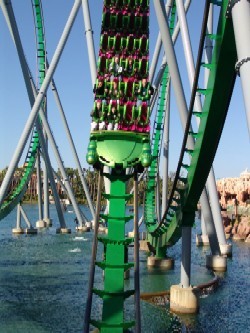 This spring will see the opening of the world’s tallest and fastest roller coaster. New Jersey’s Kingda Ka will accelerate to 128 miles per hour in 3.5 seconds, drop 418 feet into a 270-degree spiral, soar over a 129-foot hill and glide back into its station.
This spring will see the opening of the world’s tallest and fastest roller coaster. New Jersey’s Kingda Ka will accelerate to 128 miles per hour in 3.5 seconds, drop 418 feet into a 270-degree spiral, soar over a 129-foot hill and glide back into its station.
Statistically, roller coasters are actually safer than lawn chairs. But riders are drawn to the illusion of danger, and that’s spawning a new science of fear.
“We always try to make them look and feel more dangerous than they really are,” Michael Boodley of Great Coasters International told Psychology Today.
Good coasters exploit the universal fears of heights and falling. Riders want to feel a loss of control. “The closest thing to compare it to is driving with an idiot,” Boodley says.
Purists like rickety wooden coasters, where there’s a slow buildup and more time to fret about safety. “There’s a lot of self-abuse on that chain lift,” Boodley said. “Your own mind puts you in a state of paralysis.”
“LIMs,” the newer rides driven by linear induction motors, forgo that in favor of raw power, but they do exploit psychology by inverting the cars and suspending riders in space. (At Busch Gardens Tampa you’re actually dangled over a pit of live crocodiles.) And the very violence of a LIM ride — on some you’ll pull up to 4 Gs — is unfamiliar and thus scary.
Whichever your choice, your ride will probably last only a minute. That’s because the ride is accurately named: After the first burst of speed, the rolling cars are literally coasting.
